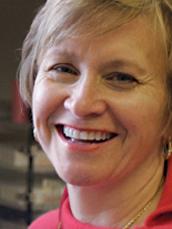Dr. Grace Wyngaard Biology professor and Madison Scholar
Women For Madison Perhaps it was growing up near the water in upstate New York and the New Jersey shore that attracted Grace to change. "I knew I wanted a profession that was sure to be always changing, rather than becoming boring," she says. Science was a natural fit. "Science is all about advancing our knowledge. Often this entails overthrowing old ideas and replacing them with new ideas that better fit our current data and knowledge. So, a life in science demands that one be prepared to constantly change and to always question what we believe to be true," Grace explains. She has vigorously pursued her thirst for knowledge, garnering recognition from her peers along the way. She began teaching at JMU in 1988 and currently studies why tiny crustaceans excise DNA during early development and whether repeated DNA sequences found in many organisms are functional or "junk." This research on copepod development, which might reveal some big clues about the evolution of species, landed in the pages of the journal Evolution in March 2006. She has also worked at the National Science Foundation, most recently as director of the integrated biology and neuroscience division. During her first year at NSF, she developed the Undergraduate Mentoring in Environmental Biology grant program, which encourages minority students at small colleges to study science through work with faculty mentors at research universities. "Until we have a cross section of the U.S. population engaged in research, we won't have a competitive, scientific workforce," she says. In 2004, she was elected a fellow of the American Association for the Advancement of Science, recognized by her peers for her distinguished and innovative leadership.
Perhaps it was growing up near the water in upstate New York and the New Jersey shore that attracted Grace to change. "I knew I wanted a profession that was sure to be always changing, rather than becoming boring," she says. Science was a natural fit. "Science is all about advancing our knowledge. Often this entails overthrowing old ideas and replacing them with new ideas that better fit our current data and knowledge. So, a life in science demands that one be prepared to constantly change and to always question what we believe to be true," Grace explains. She has vigorously pursued her thirst for knowledge, garnering recognition from her peers along the way. She began teaching at JMU in 1988 and currently studies why tiny crustaceans excise DNA during early development and whether repeated DNA sequences found in many organisms are functional or "junk." This research on copepod development, which might reveal some big clues about the evolution of species, landed in the pages of the journal Evolution in March 2006. She has also worked at the National Science Foundation, most recently as director of the integrated biology and neuroscience division. During her first year at NSF, she developed the Undergraduate Mentoring in Environmental Biology grant program, which encourages minority students at small colleges to study science through work with faculty mentors at research universities. "Until we have a cross section of the U.S. population engaged in research, we won't have a competitive, scientific workforce," she says. In 2004, she was elected a fellow of the American Association for the Advancement of Science, recognized by her peers for her distinguished and innovative leadership.
"JMU is exceptional in being student centered and striving to provide each student with hands-on experiences in their field of interest. Faculty in the sciences believe strongly that by engaging students as partners in their research programs they can nurture student researchers to the point that they become collaborators and competitive for top graduate programs in the country."

